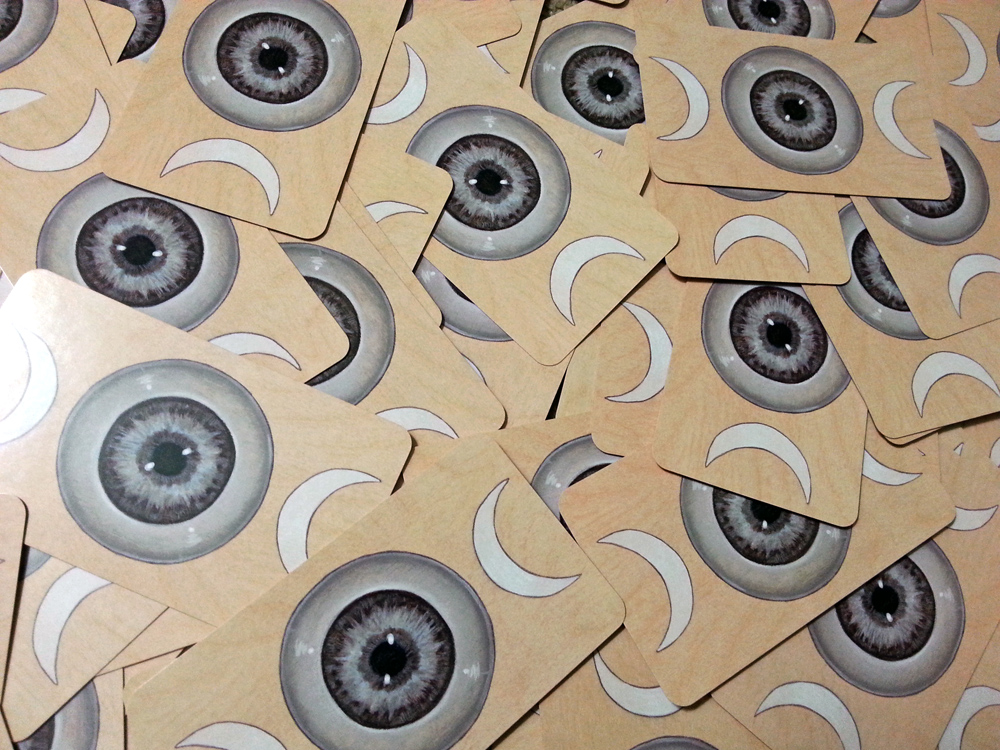The Wooden Tarot is a 79-card self-published tarot deck by Atlanta-based artist A. L. Swartz in 2014(?). The deck was conceived in the Rider-Waite-Smith tradition, but Swartz’s unique style and artistic preoccupations make this deck a big departure from mainstream visual tarot traditions. The Wooden Tarot features no human beings, with the exception of a human skull on the Devil card and the four Gods, or aces, with human-bodies but floating eyeballs for heads. The imagery of the deck is instead nature-based, including everything from bones to mushrooms to crystals, and an eclectic mix of animals, from the more familiar White-Tailed Deer to the fairly exotic Blue Angel Nudibranch.
This is a bizarre world, however, one in which animals may have sunflowers or mushrooms for heads, or crystals may grow directly out of their bodies. Third-eyes abound, showing us that the Wooden Tarot hovers somewhere between the natural realm and the spirit realm.
One of the most striking features of the Wooden Tarot, however, is that it does not include any sort of booklet of card meanings. At the time I purchased the deck, Swartz stated on his Etsy page that any book of Rider-Waite-Smith meanings could be used alongside the deck. Many people, however, have found the deck’s visual simplicity, its wide range of plants and animals, and its severe departure from Rider-Waite-Smith imagery to be intimidating or confusing.
When I first got back into tarot in early 2015 and began looking at decks to buy, I was for several months trying to decide between the Wild Unknown and the Wooden Tarot. I chose the Wild Unknown in the end, which was probably wise, given that the learning curve for the Wooden Tarot is a bit steeper than that of the Wild Unknown, which I struggled with at the time.
I purchased the Wooden Tarot after I felt more comfortable with the Rider-Waite-Smith system, and was almost immediately drawn to the challenge of writing a blog post description for each card. To be clear, I do not consider this to be a definitive or “correct” interpretation of the deck in any way. Other people have looked at the same card as me and taken away vastly different interpretations. My interpretations are as much a reflection of myself and my place in my tarot journey as they are a reflection of the cards.
I took on this project because I wanted to learn more about the Wooden Tarot. Over time, I have come to see that, while this series has taught me a lot about this particular deck, it has also taught me a lot about the tarot in general, made me reassess my interpretations of the RWS system, and also try to understand how the Thoth relates to that system. I have also begun to realize that other people find this series helpful, and than a good percentage of my blog hits come from people trying to find an interpretation of a specific Wooden Tarot card. Thus, while this series is for my own knowledge I am also gratified if I can help others.
It’s rumored that Swartz is coming out with his own book of card meanings, given the feedback he has received that people have difficulty using the deck without one. I will finish this series for my own learning, and because while I’m sure that my interpretations will overlap with Swartz’s to a certain extent, they will also reflect a unique perspective on the deck. I do plan, however, to read Swartz’s meanings once I have finished the series.
For those interested in more about this deck, there is a Wooden Tarot Study Group on Facebook, which is quite active and in which Swartz himself sometimes participates. Swartz also has a playing-card-sized oracle deck, the Earthbound Oracle, which shares many of the same visual themes with the Wooden Tarot and works with it beautifully.
If you are ready to dive in, begin here.
________________________________
Information for those interested in purchasing the deck:
The Wooden Tarot is more or less a standard sized tarot deck. The backs feature a triple-moon design, with a large eyeball taking the place of the full moon and are reversible. (Since the design for the backs was painted on wood, it’s not 100% reversible, given the natural variability of wood grain. However, I am very picky about this sort of thing and I use reversals with this deck quite easily.)
The card stock of the Wooden Tarot is very high quality. It is flexible but strong and has a buttery finish that surpasses any tarot deck or playing cards I have handled. The cards stand up to repeated riffling and have not chipped or frayed after several months’-worth of use. I imagine that this deck will withstand years of tarot readings. The deck comes in a tuck box, which I personally do not use to store it, as tuck boxes generally cannot stand up to frequent use. I recommend making or buying a bag for this deck.
At this moment, the deck is priced at US$35 plus shipping and can be found on skullgarden.com or Swartz’s Etsy shop.

Leave a Reply